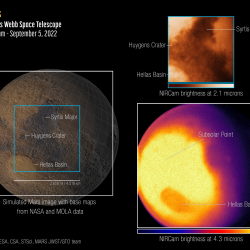Space mission development
Despite decades of research at BIRA-IASB, Earth’s atmosphere has not revealed all of its secrets yet. New space missions are being developed to further investigate the composition of the Earth’s atmosphere, like ESA’s:
- PICASSO CubeSat
- ALTIUS missions
Both initiated by BIRA-IASB.
Scientists’ insatiable curiosity makes us dive deeper into our solar system. After our latest flagships (ROSINA on Rosetta, SOIR on Venus Express, NOMAD on ExoMars), our engineers are working on the next generation instruments to be launched towards Venus and even Jupiter.

We are proud to present a new introductory film, in which the Royal Belgian Institute is being presented in all its facets. Discover the many fields of research and societal challenges in which the Institute is active.
On January 31, King Philippe of Belgium visited the Space Pole and the Institute for Space Aeronomy. Scientists of BIRA-IASB presented him a glimpse of our climate, air quality and ozone layer research.
ESA, the European Space Agency, has downselected the shortlist for its next ‘medium’ science mission to three finalists: M-Matisse, Plasma Observatory and Theseus.
On 13 April 2023, the ESA spacecraft JUICE will take off on board an Ariane 5 launcher from ESA’s Spaceport in Kourou, French Guyana. After an 8-year-long journey, JUICE will investigate Jupiter and its icy moons, with a special focus on Ganymede, the largest moon in the solar system.
September 2 marked the two-year anniversary of PICASSO’s launch, the first CubeSat mission of BIRA-IASB.
Comets contain contain organic material older than the solar system, as is shown by data gathered by the DFMS instrument, which flew on board the Rosetta spacecraft to study comet Chury. An instrument and discovery to which BIRA-IASB scientists and engineers have contributed.
The Space Pole in Uccle opens its doors to the public on September 24 and 25, 2022.
Two years after its launch, ExoMars Trace Gas Orbiter (TGO) settles in its final orbit around Mars. The satellite carries the instrument NOMAD of the Royal Belgian Institute for Space Aeronomy (BIRA-IASB) on board.
BIRA-IASB is sending an instrument to Venus. The VenSpec-H instrument will fly with the EnVision mission, which has just been selected by ESA and is planned for launch in 2031-2032.
A team of the Royal Belgian Institute for Space Aeronomy is working on the characterisation of a space instrument called MAJIS, for ESA's JUICE mission to the planet Jupiter and its icy moons.
The launch of Vega Flight VV16, which will put the Belgian CubeSats PICASSO and SIMBA into orbit, has been postponed to August.
Two Belgian CubeSats, PICASSO (from the Royal Belgian Institute for Space Aeronomy) and SIMBA (from the Royal Meteorological Institute) were launched simultaneously with about 50 tiny satellites, on board Europe’s inaugural Vega SSMS flight.
Jurgen Vanhamel completed his PhD in a collaboration between BIRA-IASB and KU Leuven, and was partially based on the ALTIUS-project.
Picosatellite PICASSO, aimed at Earth observation and space science, the first CubeSat mission, was successfully integrated into its launch dispenser.
The ‘Comet Interceptor’ has been selected as ESA’s new fast-class mission in its Cosmic Vision Programme. Comprising three spacecraft, it will be the first to visit a truly pristine comet.
Precise measurement of the solar spectrum outside the atmosphere and its variability.
Prestigious journal Nature publishes two papers describing the first results of the Belgian NOMAD instrument on board ExoMars Trace Gas Orbiter.

